“A quiet, peaceful inner awareness or wakefulness with sleep at the surface, but bliss, pure consciousness, and sublimity underneath.” —J.A.S.
Can something so personal and subjective as the inner experience of enlightenment be verified by the hard objective measures of scientific research? Yes! The groundbreaking research of Lynne Israelson Mason, Ph.D., did exactly that. Her study was published in the renowned, peer-reviewed journal Sleep: “Electrophysiological Correlates of Higher States of Consciousness during Sleep in Long-Term Practitioners of the Transcendental Meditation Program (pdf).”

David Orme-Johnson, Ph.D.
In my interview with Dr. Mason, she takes us behind the scenes to tell us how this research at Maharishi International University (MIU) came about, and what the results mean for our understanding of the full development of human potential.1,2
First, let’s define some of the key features of Cosmic Consciousness.
What Is Cosmic Consciousness?
As we discussed in Part 4 of the Scientific Quest for Enlightenment Series—“What Is Cosmic Consciousness?”—regular twice-a-day practice of the Transcendental Meditation technique alternated with daily activity progressively habituates the nervous system to maintain Transcendental Consciousness, the fourth state, along with waking, dreaming, and sleep states of consciousness.
This gives rise to the development of a fifth state of consciousness, which TM Founder Maharishi Mahesh Yogi called Cosmic Consciousness. Maharishi explained that the enlightened state of Cosmic Consciousness arises spontaneously and naturally when the nervous system becomes sufficiently stress-free and is functioning normally.
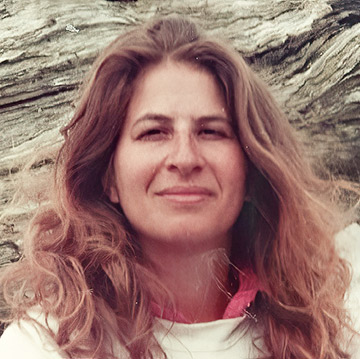
Lynne Israelson Mason, Ph.D.
Until Dr. Mason’s study, there was a great deal of indirect scientific evidence that regular practice of the TM technique develops one’s physiology, psychology, and social behavior in the direction of Cosmic Consciousness. For example, longitudinal research has found that regular TM practice increases alpha1 EEG brainwaves and coherence,3,4,5 reduces stress,6 anxiety,7-10 and depression,11-15 and increases self-actualization16,17 and self-realization.18 These are all qualities predicted by Maharishi to increase with the development of Cosmic Consciousness.
But before Dr. Mason’s study, no research had yet shown that people who were experiencing inner unbounded awareness during sleep, showed the predicted biomarker (a measurable phenomenon of a particular state) of Transcendental Consciousness—alpha1 EEG brainwaves—during deep sleep.
Maharishi explained that the enlightened state of Cosmic Consciousness arises spontaneously and naturally when the nervous system becomes sufficiently stress-free and is functioning normally.
What Is Witnessing?
A hallmark of rising Cosmic Consciousness is when TM practitioners experience the silence and expansion of Transcendental Consciousness during the different phases of waking, dreaming, and sleep. This phenomenon is experienced as witnessing, the awareness that one’s unbounded, silent Self deep within seems to be watching one’s activities while remaining uninvolved with them.
Witnessing is the result of a fundamental change in how one experiences the Self, or Transcendental Consciousness, in relation to the external world. It is not based on an idea or a mood but is a natural and spontaneous result of Transcendental Consciousness being experienced not only during TM practice but also along with activity during the day. Witnessing first develops during different phases of activity, and eventually it is not lost even during dreaming or deep sleep.
Witnessing sleep is described as a continuous inner glow of awareness of the body as it settles down, falls asleep, and then wakes up again.
Witnessing of deep sleep is the most reliable indicator that Cosmic Consciousness is well developed, and this is the criterion that Dr. Mason used to select her subjects. Witnessing sleep is described as a continuous inner glow of awareness of the body as it settles down, falls asleep, and then wakes up again. It is not insomnia, which is full of thoughts, images, feelings, and sometimes agitation, but is a very quiet and settled state, often blissful in nature.
Since one of the key biomarkers of Transcendental Consciousness is a brainwave frequency called alpha1 EEG 8–10 cycles per second, Dr. Mason and her colleagues reasoned that if one of the characteristics of Cosmic Consciousness is that the experience of the inner wakefulness of Transcendental Consciousness is not lost during sleep, then people who are experiencing Cosmic Consciousness should show alpha 1 even during sleep. This would be very unusual and revolutionary because alpha1 is not ordinarily seen during sleep. Alpha1 represents restful alertness, which is seen when the mind is wide awake inside but silent, and the screen of awareness has no content.
The Story of Dr. Lynne Mason’s Groundbreaking Study
Dr. David Orme-Johnson: Lynne, let’s begin with a basic question. How did you come to the idea of doing your doctoral dissertation in psychology on Cosmic Consciousness? That’s really thinking out of the box. It must have been a formidable undertaking.
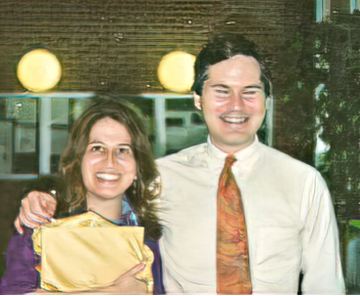
Lynne Mason, Ph.D., with Charles “Skip” Alexander, Ph.D., her thesis advisor and one of her co-authors
Dr. Lynne Isaraelson Mason: This project was completely inspired by my thesis advisor at MIU in Fairfield, Iowa, Dr. Charles Alexander, or Skip, as everyone called him. He called me to his home office and said he wanted me to do a study on Cosmic Consciousness and witnessing sleep. “I think you are the one to do this project,” he said. I later learned he had asked at least one other fellow student first, but they declined, as they thought the project would be too time-consuming and challenging.
DOJ: You were very brave.
LM: Or naïve. But I loved Skip, and I was so moved by how much he wanted to do this. He said, “I think it is very important, and now is the time to do it. You have good intuition, great support of nature, and you are intelligent, so you can learn any technical skills you will need.”
I had such a deep experience of witnessing activity, when he asked me. I heard a voice say, “Yes, I will do it.” I turned around to see who said, “Yes,” but no one was behind me. I realized it was me!
Then I quickly backtracked and said if we have some success, we will keep going. Otherwise, we will have to pick another topic. It was a bit daunting. I saw I was going to have to learn all the EEG technical details and skills, and I had to figure out how to identify and select subjects reporting experiences of Cosmic Consciousness.
Skip stood by and encouraged me for the whole project. He completely believed we would get the “support of nature” we needed, and he was right. As the study unfolded, he would say, “Here you go again, getting all this help from unexpected places. Keep going, Lynne!”
DOJ: Skip was one of the most brilliant, accomplished, published, and beloved faculty of the MIU Psychology Department. Readers can learn more about Dr. Alexander in the tribute I wrote to accompany this article: “A Legendary TM Researcher, Advisor, and Teacher.”
LM: Thank you for writing that, David, for all of us. Skip also encouraged my intuition when I felt the only way I could do this project was to do as long a meditation program as was recommended and possible with my schedule, and to follow the recommended routine as best as I could. I wanted to get the maximum support of nature. I also felt that if I was going to do a study on enlightenment, I needed to have as much experience of the transcendent as possible.
DOJ: You obviously did get that support, because you accomplished the study and got it published in a very good journal called Sleep, which is the benchmark international journal for sleep and circadian science. Its mission is to publish innovative, high-impact research findings that advance our understanding of sleep and circadian rhythms, as well as their contributions to health and disease. Your study on Cosmic Consciousness certainly did that.
LM: Thank you—with a lot of guidance and assistance from my colleagues.
“If I was going to do a study on enlightenment, I needed to have as much experience of the transcendent as possible.” —Dr. Lynne Mason
DOJ: Let’s start with the basics. Can you tell us about what Cosmic Consciousness is?
LM: Maharishi explains with an analogy how regular TM practice develops Cosmic Consciousness. He says it’s like the process of dying a cloth. To dye a white sheet golden yellow, you dip it into the yellow dye and hang it out in the sun. Soon, the sun fades out most of the color, so you repeatedly dip it into the dye, then hang it in the sun again. Each time, a little more of the golden color remains, until eventually, the sheet is brightly dyed gold and does not fade. (See Maharishi’s talk, “The Time-Tested Formula to Develop Cosmic Consciousness—Rest and Activity.”)
DOJ: A very famous analogy by Maharishi. After meditation one still feels the glow of TM practice lasting for some time afterwards. Activity makes it fade, but over time it lasts longer and longer into activity.
LM: And eventually, that inner awareness lasts all day—and not only all day, but also all night: during sleep, during dreaming, and continuing when you wake up in the morning. In other words, witnessing 24 hours a day. Skip and I wanted to study subjects who were having this experience of 24-hour witnessing. Maharishi also called it 24-hour bliss. We wanted to know how their brains were functioning while they were sleeping.
DOJ: Cosmic Consciousness is a whole new take on circadian rhythms. But why is the experience called witnessing? What is it that a person in Cosmic Consciousness is observing or witnessing?
LIM: It is called witnessing because one is always inwardly awake. The transcendent Self, or pure consciousness, is as if watching the cycles of the day and night come and go. One is “observing” everything that happens, at all times.
DOJ: I am eager to hear some examples of witnessing sleep from your subjects, but we’ll get to that in a moment.
“Eventually, that inner awareness lasts all day… during sleep, during dreaming, and continuing when you wake up in the morning… Maharishi also called it 24-hour bliss.” —Dr. Lynne Mason
How Do Researchers Do Sleep Research?
DOJ: Since we don’t have a sleep lab at MIU, where did you do the study? How did you get training in doing sleep research?
LM: There was an overnight sleep lab at a hospital nearby, in Ottumwa, Iowa. For training during the pilot, we did overnight sleep studies there. They were very generous with their time, helping me and educating me in sleep medicine. That observation and training gave me a feel for what doing sleep research with EEG involved.
I showed Skip some published EEG studies using ambulatory, or mobile, EEG recordings, and he was open to the idea of recording the subjects in their own homes using this technology. We wanted the volunteers to be as comfortable as possible. EEG wires are placed on the scalp, as in a routine EEG, then attached to a special recorder. Since the recorder wasn’t that big, just 6 by 5 by 2 inches, the subjects could take it home and didn’t have to sleep in the lab. I went for training in the ambulatory system at the EEG lab in the Ottumwa hospital. So many kind people, especially many professional women, helped us along the way.
Then I contacted the well-known Duke Clinic Sleep Laboratory at Duke University. I was invited to Duke by Gail Marsh, Ph.D., a very accomplished sleep researcher, who became my co-author and collaborator. He and his engineers were instrumental in training me in the analysis. He had no previous connection to the TM program but was so willing to help us and gave so freely of his time and expertise in ambulatory sleep research. I can’t believe how fortunate we were. Dr. Marsh was such a gentle teacher. He approved our use of their sleep analysis software, which was very generous, as we had a modest budget.
“We wanted the volunteers to be as comfortable as possible. EEG wires are placed on the scalp, then attached to a special recorder… The subjects could take it home and didn’t have to sleep in the lab.” —Dr. Lynne Mason
The TM community in Raleigh, North Carolina, near Duke University, was also very supportive. They provided me and my husband, David Mason, with a place to stay and meditate while I completed my training. When David and I first arrived at Duke, we almost turned back scared because just about everyone had blue painted faces and horns, and there were tents all over the campus quad. We came to find out they were the Blue Devils team in the Sweet 16 NCAA Division 1 Basketball Championship.
DOJ: A couple of MIU “angels” meet the Duke Blue Devils.
LM: That’s good! David was an MIU math and physics major then, and he helped with my training at Duke. He had a knack for quickly rephrasing any of the engineers’ unfamiliar technical terms, which saved a lot of time for me and the engineers. He also volunteered to let me test any new techniques for attaching electrodes on him. He often went around with clumps of glue still in his curly hair. He always believed in the importance of this study, was a sounding board for all my ideas, and became one of my co-authors.
DOJ: You’re a great team.
Finding Subjects Who Were Witnessing Sleep
DOJ: Once you returned to MIU and Fairfield after your training, how did you find subjects who were witnessing sleep? Did you put an ad in the newspaper? “Study on Cosmic Consciousness: Please contact Lynne Mason and sign up.”

Practitioners of the TM and TM-Sidhi programs gather twice daily in two meditation domes at Maharishi International University
LM: (Laughs.) At MIU, people at the university and in the community do their TM and TM-Sidhi® programs together in the Golden Domes twice a day, morning and afternoon. The experimental subjects were all part of that supportive community in Fairfield, and very dedicated to group practice in the Domes, which is very powerful. (See “Can Large Group Meditations Create a More Peaceful World?”) They felt their experiences of Cosmic Consciousness developed as a result of their regular TM and TM-Sidhi practice.
I whispered to a few friends what I was doing, and suggestions for potential subjects came forward. I had one highly reliable, long-term TM teacher recommend a possible participant that had been experiencing higher states of consciousness. Then that person recommended another participant, and it just unfolded. Birds of a feather seemed to flock together.
“The experimental subjects were all part of that supportive community in Fairfield… They felt their experiences of Cosmic Consciousness developed as a result of their regular TM and TM-Sidhi practice.” —Dr. Lynne Mason
As an illustration of “support of nature,” I often had a very strong intuition about when I was supposed to be somewhere at a certain time that would help me with the research or find a possible participant. I felt like there was a “cosmic GPS system” guiding me to go to certain places at specific times.
I ended up with 11 volunteers reporting experiences of witnessing deep sleep who were willing to participate: 9 women and 2 men. Their ages ranged from 31 to 50 years old. The mean age was 39.7 yrs. ± 5 yrs. Their average length of time practicing the TM technique was 17.8 yrs. ± 4.9 yrs. If memory serves, they had been meditating at least 5 years before they started having witnessing experiences.
Personal Reports of Witnessing Sleep
DOJ: Could you give us some examples of how they described witnessing sleep? And what was it like interviewing your subjects?
LM: Yes, here are some examples from my dissertation:2
“I know I am not awake because my body is asleep, deeply asleep. I am totally awake inside, but my body is asleep… I have a faint memory of what sleep used to be like before witnessing sleep. It used to be nothing, just dead, soft black, absorbing blackness, [and] my awareness was totally gonzo. Now it is the absence of activity, but it’s black that is backlit with light. Black is the absence of activity, but it’s backlit with the light of inner wakefulness.” —B.W.I.
“There is this blank space before dreaming and it is witnessing dreamless sleep. I am not aware of how long that experience lasts. It’s just like waiting for a movie to begin… It’s just like looking at a screen there, and inner wakefulness is there.” —M.S.T.
“I have had the experience of maintaining awareness while each of the senses in succession gave over their functioning to silence, and I was left in pure awareness for the whole night. I have also experienced awareness of the bliss and light dominating, and just becoming more full with sleep onset. Later in the morning, there was no inertia, just a sense of ‘time to get up’ and opening my eyes and getting up… I was clearly sleeping, oblivious to everything outside, yet some sameness, unchanging value, continued as I slept.” —G.M.E.
“There is just awareness, a knowingness, that I am. When I awaken I know I’ve always been there. There is a continuum of time. Life is unbroken. Sleep is sweet, full, aware… I am aware of my Self, bliss, silence, unmanifest light, and unmanifest creation… When falling asleep or waking, my conscious thinking mind just fades out and in… During deep sleep there is just Being.” —D.R.B.
“It’s just natural, so I don’t really notice it. A quiet, peaceful inner awareness or wakefulness with sleep at the surface, but bliss, pure consciousness, and sublimity underneath. I am aware of God’s bliss, love, Being, the universe sleeping or dissolved.” —J.A.S.
“During sleep, there is a strong awareness of unboundedness. I experience bliss all night long, accompanied with a golden color… always accompanied by a feeling of complete naturalness and sweetness.” —A.M.O.
“Sleep can sometimes feel like an ocean of warm contentment, reposing in a perfectly fulfilled state. The same beautiful awareness of Self, a silent ocean of contentment…with no significant change in quality [of witnessing] through waking, sleeping, dreaming, and waking again.” —C.R.I.
LM: It was very inspiring to hear the participants report their experiences during the interviews. Sometimes I felt that I was starting to get a taste of what they were describing, or I realized I had had a similar but briefer glimpse of a certain experience.
Editor’s note: For more descriptions of witnessing sleep and activity, see the excerpt from Dr. Tony Nader’s book, One Unbounded Ocean of Consciousness, “Cosmic Consciousness—Living the Fullness of Inner Silence and Bliss 24 Hours a Day,” and from Dr. Craig Pearson’s book, The Supreme Awakening, “7 States of Consciousness—Unlimited Possibilities for Personal Development.”
EEG Evidence of Cosmic Consciousness
DOJ: What did you find in your sleep research on these experiences?
LM: Cosmic Consciousness is described as Transcendental Consciousness along with waking, dreaming, and sleep states of consciousness. Our prediction was that people in Cosmic Consciousness should show the EEG signature of Transcendental Consciousness coexisting with the EEG signature of sleep. These two brainwave signatures are quite different from each other and are not usually found together.
Deep sleep is also called delta sleep because it is characterized by a very slow, 1–2 HZ high-amplitude EEG wave called delta. The chart below is an example of the EEG polygraph tracing from our study. The red arrows point to the slow, large amplitude delta wave of deep sleep. The blue arrows point to the fast theta2/slow alpha1 EEG wave (6–10 Hz), which indicates Transcendental Consciousness. You can see that the Transcendental Consciousness wave is riding on top of the sleep wave. It was very exciting to see Cosmic Consciousness portrayed so graphically in the tracing of brainwave activity.
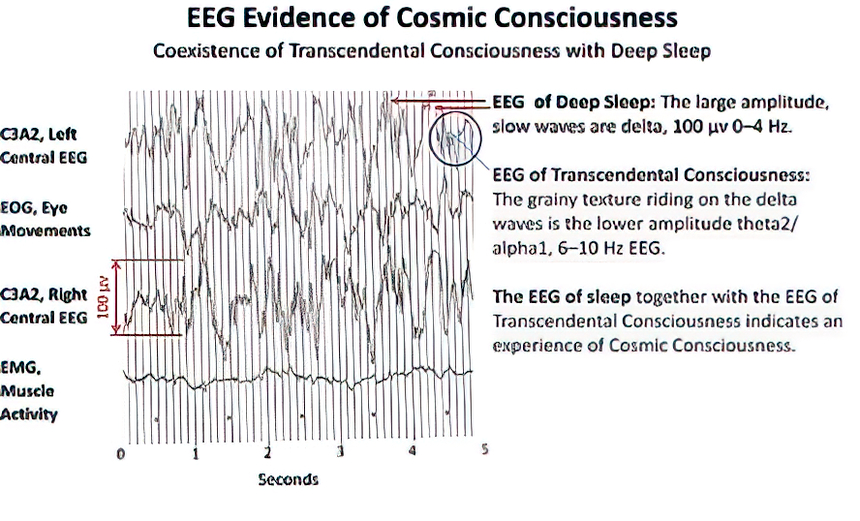
Polygraph tracing from Sleep study showing the coexistence of Transcendental Consciousness with deep sleep (L. I. Mason, et al, “Electrophysiological correlates of higher states of consciousness during sleep in long-term practitioners of the Transcendental Meditation program,” Sleep 20, no. 2 (1997): 102-110).
This polygraph tracing shows four different leads. From top to bottom they are EEG (brainwave activity) from the left side of the head in the central cortex, EOG (eye movements), EEG from the right central cortex, and EMG (muscle activity). The coexistence of the EEG of Transcendental Consciousness (blue arrows) with the EEG of sleep (red arrows) is an indication of Cosmic Consciousness. The chart below highlights these two distinct EEG patterns of the inner awareness of witnessing coexisting with deep sleep.

Highlighted EEG waves for Transcendental Consciousness and deep sleep (L. I. Mason, et al, “Electrophysiological correlates of higher states of consciousness during sleep in long-term practitioners of the Transcendental Meditation program,” Sleep 20, no. 2 (1997): 102-110).
We had the computer calculate exactly what percentage of the EEG during sleep was theta2-alpha1, indicating restful alertness. This was the index of Cosmic Consciousness for each of the three groups in the study. The chart below shows the results.
The tallest bar (on the left) is for the experimental subjects who were witnessing sleep. They showed the highest percentage of theta2-alpha1, which was significantly more than the second group of subjects, who were short-term practitioners of TM who were not yet witnessing. The short-term TM group, in turn, had significantly more theta2-alpha1 than the third group, who were not practicing TM and were not witnessing.
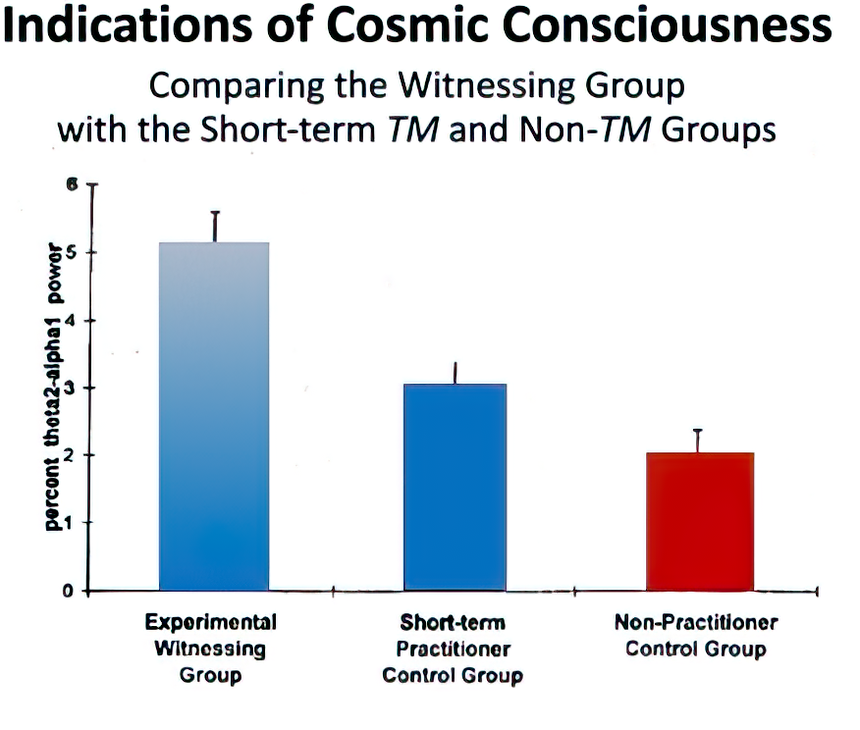
Mean percent of theta2-alpha1 in the EEG for the three groups and the amount of deep sleep, EMG muscle activity and REM (rapid eye movement) results (L. I. Mason, et al, “Electrophysiological correlates of higher states of consciousness during sleep in long-term practitioners of the Transcendental Meditation program,” Sleep 20, no. 2 (1997): 102-110).
This chart shows that there was a graded difference across groups during sleep stages 3 and 4 in theta2-alpha1 power, with the experimental subjects having greater power than short-term practitioners, who in turn had greater power than those who were not TM practitioners (p = 0.00002). There was no difference between groups in time in deep (delta) sleep. In other words, this result, that the witnessing group had a significantly higher percentage of theta2-alpha1 than either of the non-witnessing control groups, proved that the subjects’ experience of Cosmic Consciousness was based on the presence of Transcendental Consciousness during deep sleep.
Also, there was no difference between groups on the amount of deep sleep they got. This shows that the greater theta2-alpha1 in the witnessing group was not due to light sleep. Interestingly, the witnessing group showed less EMG muscle activity, indicating they were getting a more restful sleep than the controls were getting.
DOJ: Fantastic. So you found that the witnessing subjects had more inner awareness, got just as much deep sleep as controls, and were getting a more settled, deeper rest as indicated by reduced EMG.
LM: Yes. And the fact that the short-term TM group showed significantly more theta2-alpha1 than the non-TM group indicates that the short-term TM subjects were already beginning to stabilize the physiology of Cosmic Consciousness, even though they were not yet experiencing witnessing sleep.
“This result, that the witnessing group had a significantly higher percentage of theta2-alpha1 than either of the non-witnessing control groups, proved that the subjects’ experience of Cosmic Consciousness was based on the presence of Transcendental Consciousness during deep sleep.” —Dr. Lynne Mason
The Unique EEG of People Experiencing Cosmic Consciousness
DOJ: Beautiful. Did you find anything else?
LM: Yes. The witnessing subjects showed increased rapid eye movement (REM) density during dreaming (REM sleep) than the meditating controls.
DOJ: What does that indicate?
LM: Increased REM density in the subjects witnessing sleep could be viewed as an indication of a somewhat lessened sleep depth due to the inner awareness of witnessing. REM density also has been found to increase with maturation, increased intelligence, and personality development.
DOJ: So increased REM density may be part of the holistic growth of the personality in Cosmic Consciousness, indicating greater maturity and intelligence?
LM: Yes, perhaps, but at least it shows that the people who were witnessing sleep have a different sleep physiology than people who are not witnessing. What we emphasized in the discussion in our paper is that the people witnessing sleep have a unique pattern that is different from people not witnessing, and that the pattern describes a different major state of consciousness, the fifth state of what Maharishi describes as the seven states of consciousness, or Cosmic Consciousness.1
We wrote that each ordinary state of consciousness—waking, deep sleep, and dreaming (REM)—is accompanied by a unique subjective description of experience as well as state-specific EEG, EMG, and eye movement patterns. The pattern of people reporting witnessing of sleep was different than that of people not witnessing. They had the subjective experience of inner awareness during sleep; they had more theta2-alpha1 EEG; they had less muscle activity (EMG); and they had more REM density. This unique pattern indicates that witnessing sleep is indicative of a fifth major state of consciousness, Cosmic Consciousness.
“The people witnessing sleep have a unique pattern that is different from people not witnessing, and the pattern describes a different major state of consciousness, the fifth state of what Maharishi describes as the seven states of consciousness, or Cosmic Consciousness.” —Dr. Lynne Mason
DOJ: Excellent. This is very parallel to the logic that Robert Keith Wallace, Ph.D., used in his doctoral dissertation at UCLA in 1970, which he published in Science, Scientific American, and the American Journal of Physiology.19-21 He established that the pattern of physiological changes and subjective reports during TM practice were uniquely different from ordinary rest, indicating a fourth major state of consciousness. This unique fourth state—Transcendental Consciousness—was indicated by the meditators’ reports of inner awareness associated with alpha1 EEG, while their autonomic parameters indicated greater reductions in rate of breathing, heart rate, oxygen consumption, and arterial lactate, and greater increases in skin resistance, as compared to ordinary rest with eyes closed.
Now we have the unique patterns of Transcendental Consciousness and Cosmic Consciousness. You took the story of enlightenment over the finish line for a touchdown. Congratulations to you and all your co-authors.
It Takes an Enlightened Village…
LM: Thank you, David. I stood on the enlightened shoulders of many researchers and especially my co-authors. Skip thoroughly and carefully edited the dissertation and journal article. Working with him as my editor was an amazing experience. Skip was a very gifted writer, having been trained to write from childhood by his father, who was an editor too. I totally trusted his perspective and thinking—he was brilliant.
We were also really fortunate that Dr. Fred Travis had just returned to MIU from a great position in an EEG lab at the University of California Davis Medical School. Fred’s postdoctoral research there focused on changes in sleep EEG over the course of a person’s life and the neurological development they reflect. He shared his research expertise with us all while raising his young family. He literally could change a diaper and simultaneously answer my questions about Fast Fourier EEG analysis!
And you, David, as Chairman of the MIU Psychology Department, were instrumental in approving the inclusion of the comparisons between Maharishi Vedic ScienceSM and the participants’ subjective reports of higher states of consciousness. This was boundary-breaking at the time. You also made sure I didn’t expand the dissertation project too much, so that it could actually be completed.
DOJ: I am very honored to have played even a small part in your dissertation.
“I stood on the enlightened shoulders of many researchers and especially my co-authors.” —Dr. Lynne Mason
LM: Skip introduced me to Dr. Jane Gackenbach, a leading researcher on lucid dreaming, who had a major influence on the study as an outside advisor. She had a gift of seeing the big picture and the impact of other TM research as well as the whole field of dream research. It was also so important and helpful to me to have the presence of another woman on this project. She gave me great moral support in challenging times, and also cautioned me that acceptance of this research by the wider scientific community could take a long time.
Dr. Maxwell Rainforth designed and reviewed all the statistical analysis. He was involved in every step of the statistics and brought the full power of his knowledge to this study. His expertise was invaluable, and his enthusiasm and dedication were infectious. Statistics is such a powerful tool, and having Maxwell involved was simply wonderful.
Dr. Ken Walton helped with editing, was very encouraging to me personally, and offered perspectives from outside the psychology field. He was a complete delight to work with. His kindness kept me going forward, and his quiet confidence and research experience were invaluable. He was also full of ideas for future research and has long-range vision.
And I am very grateful to all the participants in the study. They were so patient, gave so much of their time, and were dedicated to sharing Maharishi Vedic Science.
DOJ: What a great fortune to live in the community of the enlightened. We all had so much fun finding universal truths about enlightenment. It expands my heart to know that all the great enlightened beings throughout the ages, whether they were sitting in their hermitage or with their families and students, were showing theta2-alpha1 EEG in their brains while they slept!
A Blissful Postscript
DOJ: I recall that after your dissertation you had an opportunity to visit Maharishi at Maharishi European Research University (MERU) in Vlodrop, Holland. I remember you said you had blissful experiences around him. That would make a wonderful postscript to this article.
LM: Yes, I was invited to the MERU campus in the Netherlands where Maharishi lived. I received an invitation to come and rest. I thought I would be there a few days, but I was so fortunate to be there a few months. I felt so blissful and overflowing with love there. At the same time, out of the blue my husband’s employer started sending him to the Netherlands every couple of weeks, so it was perfect timing for him to visit Maharishi as well. We were able to be there during Maharishi’s annual week of silence at the beginning of the year, in 1996.
The evening Maharishi came out of silence to give a special lecture, we felt such a powerful, palpable level of deep silence in his presence. When I handed a copy of my dissertation to him, he fanned all the pages back and forth a few times. I presented and spoke about the results and answered his questions. Then Maharishi said, “This is phenomenal.” When we left the room my husband and I felt deeply that everything would work out just fine. All the questions we thought we had about the future seemed to just disappear. We felt like we were floating in bliss as we made our way down the corridor after being with him.
DOJ: You made a significant contribution to opening the door to enlightenment for the whole world. Thank you, to you and to David!
“There is a continuum of time. Life is unbroken. Sleep is sweet, full, aware… I am aware of my Self, bliss, silence, unmanifest light, and unmanifest creation.” —D.R.B.


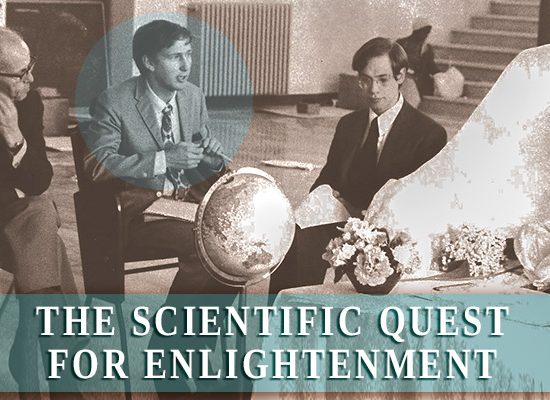


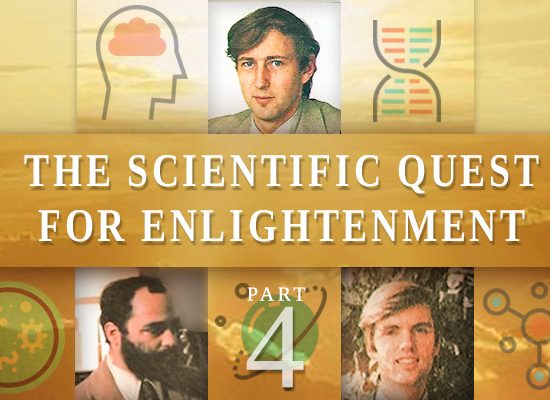
Happy Guru Purnima
Jai Guru Dev
Thank you for presenting this description of CC in such an easy to understand manner. The sleep study is a brilliant way to capture these ideas of higher states of consciousness. Many local long-time TMers converse about CC and witnessing. This will advance their understanding as it has mine. ABC
Thank you for your comment, Andrea! Dr. Orme-Johnson and Dr. Mason are brilliant at making their research on higher states accessible, and I’m so happy to hear it is having practical effects for your and others’ experience and understanding. All the best to you!